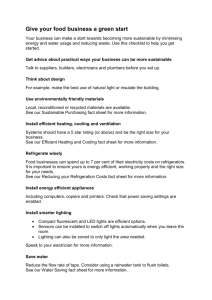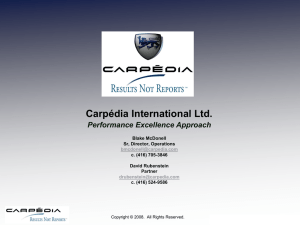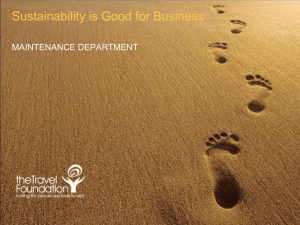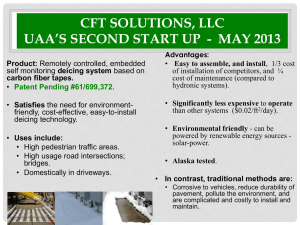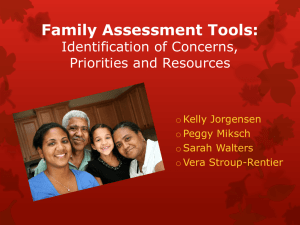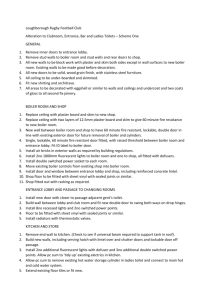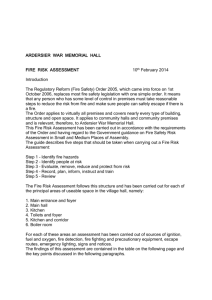Aging in Place PowerPoint Presentation
advertisement
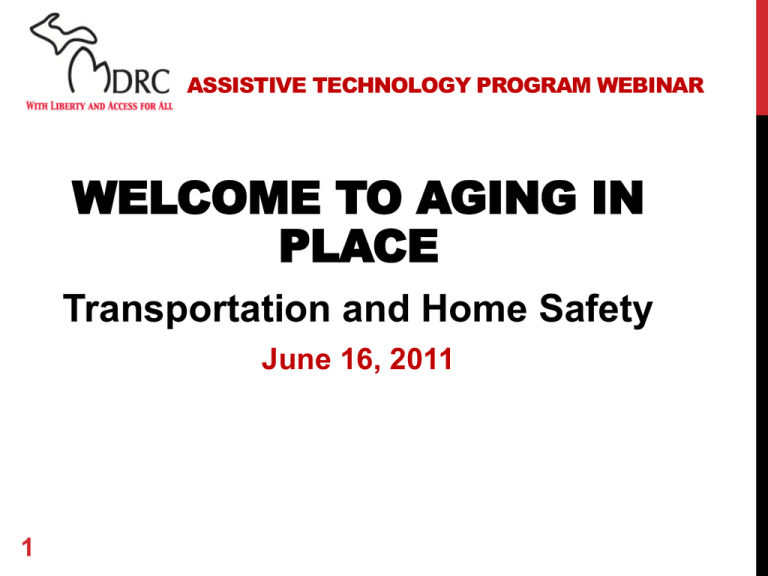
ASSISTIVE TECHNOLOGY PROGRAM WEBINAR WELCOME TO AGING IN PLACE Transportation and Home Safety June 16, 2011 1 ABOUT THE WEBINAR • Use the chat function on the right hand side. • Questions and comments are encouraged and expected! • The session is being recorded. • 22 We will start recording now. ASSISTIVE TECHNOLOGY PROGRAM WEBINAR AGING IN PLACE Transportation and Home Safety June 16, 2011 3 AGING IN PLACE • Communities should offer ways to provide necessary services for the elderly • Older adults can act as economic generators, philanthropists and volunteers • Communities prosper • In 2009, baby-boomer households in the U.S. spent about $2.6 trillion 4 AGING IN PLACE AND TRANSPORTATION ROBERTA HABOWSKI, AREA AGENCY ON AGING 1-B FUNDING PROVIDED BY: 5 INTRODUCTION • Mobility is crucial to maintaining Quality of life • Mobility decisions are as unique as the individuals involved – there is no “one size fits all” solution • Our goal is to help seniors drive as long as safely possible and/or transition to mobility options when driving is no longer an option 6 STATISTICS 7 • Older drivers account for about 15% of licensed drivers, but cause only 7% of all traffic crashes • By 2030, one in five motorist will be age 65 or older • In MI, from 2001-2010, there was a 17% increase in licensed adults age 65 +, and a 95% increase in adults between 90-99 • Most of us will outlive our ability to drive by 7-10 years! DRIVING ABILITIES • Cognitive • Visual • Physical 8 MEDICAL CONDITIONS Visual •Cataracts •Glaucoma •Macular Degeneration •Diabetic Retinopathy •Decreased night vision/glare recovery time •Decrease in depth perception Medications 9 Neurological •Stroke •Dementia •Alzheimer’s •Parkinson’s Other •Diabetes •Heart conditions •Arthritis •General aging issues SAFETY ISSUES Am I / my loved one safe to drive? •What is prompting question •Any “near misses” or unexplained damage to the vehicle •New medical diagnoses/condition/medication •Lost or confused while driving •Suggest a “ride along,” or refresher course 10 EVALUATIONS • Private – in home • Low cost, confidential • Commercial schools • Hospital rehab 11 HOSPITAL DRIVER REHABILITATION • Very in-depth evaluations • Need for training on special equipment • Generally must have physician’s referral • Stroke/Dementia/Alzheimer’s • Some vision issues 12 SPECIALIZED EQUIPMENT • More than wheelchair lifts • Use only licensed providers • May need a prescription • May need training • New vehicles – auto manufacturers may offer partial reimbursement 13 LICENSING ISSUES • Renewals • Referrals • How to report unsafe driver 14 REQUEST DRIVER EVALUATION 15 HOW/WHEN TO DISCUSS DRIVING CONCERNS • Begin discussions early, before there is a need • Talk about it along with financial retirement, end of life choices, power of attorney • Use family/friends/current events to start conversation • Express concern for their and others safety 16 TIPS FOR TALKING ABOUT DRIVING CONCERNS • Be respectful • Be specific when possible • Use “I” messages • Discuss with physician • Have an action plan • “We Need to Talk” – AARP 17 WHEN DRIVING IS NO LONGER AN OPTION • Grieving process • May need counseling • Make/review action plan • Provide a list of public, private and • personal options • Assist in finding deliveries/home services • Any other services needed 18 WHEN A LOVED ONE WILL NOT STOP DRIVING • Enlist help of family doctor • Complete and submit OC-88 form to Secretary of State • Disable the vehicle • Remove/sell vehicle 19 DID YOU KNOW? • More than half of all non-drivers age 65 and over stay at home in a given day, often because they do not have transportation options • Only half of Americans age 65 and older have access to public transportation. 20 TRANSPORTATION PLAN • Involve the transitioning driver • Remind them they still have control • Plan for driving retirement just like you would financially • Change lifestyle • Help them use the internet to shop 21 KEY TRANSPORTATION ISSUES • Basic information • Curb to Curb Service • Door through Door Service • Special equipment needs • Cost constraints • Is need on-going • Suggest making a “Transportation Plan” 22 LOCAL COMMUNITY TRANSPORTATION PLAN 23 PERSONAL TRANSPORTATION NETWORK 24 MY TRANSPORTATION PLAN 25 IN CONCLUSION • Seniors desire to remain in their homes as they age • Transportation (in own vehicle or not) is key to helping seniors age in place • Communities should provide services, including driver refresher courses, and transportation options • Livable communities value and support people throughout their lifetime 26 QUESTIONS ABOUT TRANSPORTATION? FOR MORE INFORMATION, PLEASE VISIT : The Area Agency on Aging website or call 800-852-7795 27 HOME SAFETY CHECKLIST 28 ENTRANCES & EXITS 29 • Are the pathways well lit? • Are the sidewalks and driveway in good condition? • Are there handrails on the steps? • Is the door knob easy to use? • Is there a peephole in the door? ENTRANCES & EXITS (CONT.) • Is the threshold flush with the floor? • Are there throw rugs that could cause you to fall? • Does the door lock work properly? 30 STEPS AND STAIRWAYS 31 • Are they in good condition? • Are the handrails mounted securely on the wall? One side or both? • Is there adequate lighting? • Is there clutter on the stairs? BATHROOM • What is the height of the sink, mirror and toilet? • What is the width of the doorway? • Is there a tub or shower? • Are the medicine cabinet and linen closet accessible? 32 BATHROOM (CONT.) • Are there grab bars? • Is there good lighting? • Are there adequate electrical outlets and ventilation? 33 KITCHEN • What is the height of the countertop and sink? • Where are the controls for the stove? • How does the refrigerator open? • Is there counter space near the stove? 34 KITCHEN (CONT.) • Are the cupboards accessible? What is the height? • Is there adequate lighting and ventilation? • Is there a fire extinguisher? 35 LAUNDRY • Are the machines top or front loading? • Is there room to hang clothes? 36 • Is there storage space? LIVING AREAS • What is the height of the sofa, bed and chairs? • Do rugs have non-slip tape underneath them? • Is there a chair available with arm rests? • Are light switches accessible? 37 LIVING AREAS (CONT.) • Is there adequate space to move around? • Are closets and drawers accessible? • Are electrical cords a tripping hazard? • Is there ample lighting? 38 GENERAL • Are there smoke detectors on each level of the home? • Is there a carbon monoxide detector present? • Are windows in good working condition? Can they be locked? • Is there adequate storage space? 39 LOW COST SOLUTIONS 40 EXTERIOR 41 • Install motion detector lighting • Make sure the doorbell is working. • Install a security peephole in the entry door. • Insure the mailbox is accessible. STEPS & STAIRWAYS • Install handrails on both sides of steps • Insure adequate lighting, consider night lights. • Place non-slip reflective or contrast tape on the edge of the stair tread. • Remove clutter 42 BATHROOM SOLUTIONS • Install a nightlight • Use a bathmat or nonslip strips • Install grab bars by the toilet and tub • Install a hand-held shower. 43 BATHROOM SOLUTIONS (CONTINUED) • Use an elevated toilet seat or switch to a comfort height toilet. • Consider lever type handles for the tub and sink. • Remove throw rugs! 44 KITCHEN SOLUTIONS • Use step stool to access high shelves • Change handles on cupboards • Rearrange cupboards with items used most frequently within easy reach. 45 THROUGHOUT THE HOUSE • Remove all throw rugs • Put double-sided carpet tape under area rugs • Increase lighting by opening blinds, shades and curtains • Replace light switches with rocker switches. 46 THROUGHOUT THE HOUSE (CONT.) • Replace round doorknobs with lever handles or adaptors • Ensure all electrical and phone cords are out of the path of travel. • Install off-set hinges to enlarge doorways • Install smoke detectors on every level. 47 QUESTIONS ABOUT HOME SAFETY? For more information contact: Carol Green OTRL, CAPS 248-302-4093 cgreen@flaxco.com Thank you! 48 THANK YOU Thank you for completing the online survey about this webinar. A link will be emailed to you. 49 49 Note: If you do not want to receive email notices of future assistive technology webinar opportunities, please send an email to mdrc@prosynergy.org and ask to be removed from the AT Webinar list. FINAL THOUGHTS “There is no place like home!” 50 50 --Dorothy
